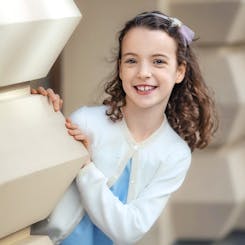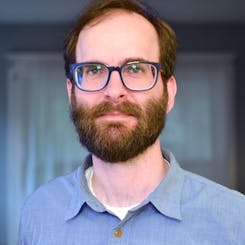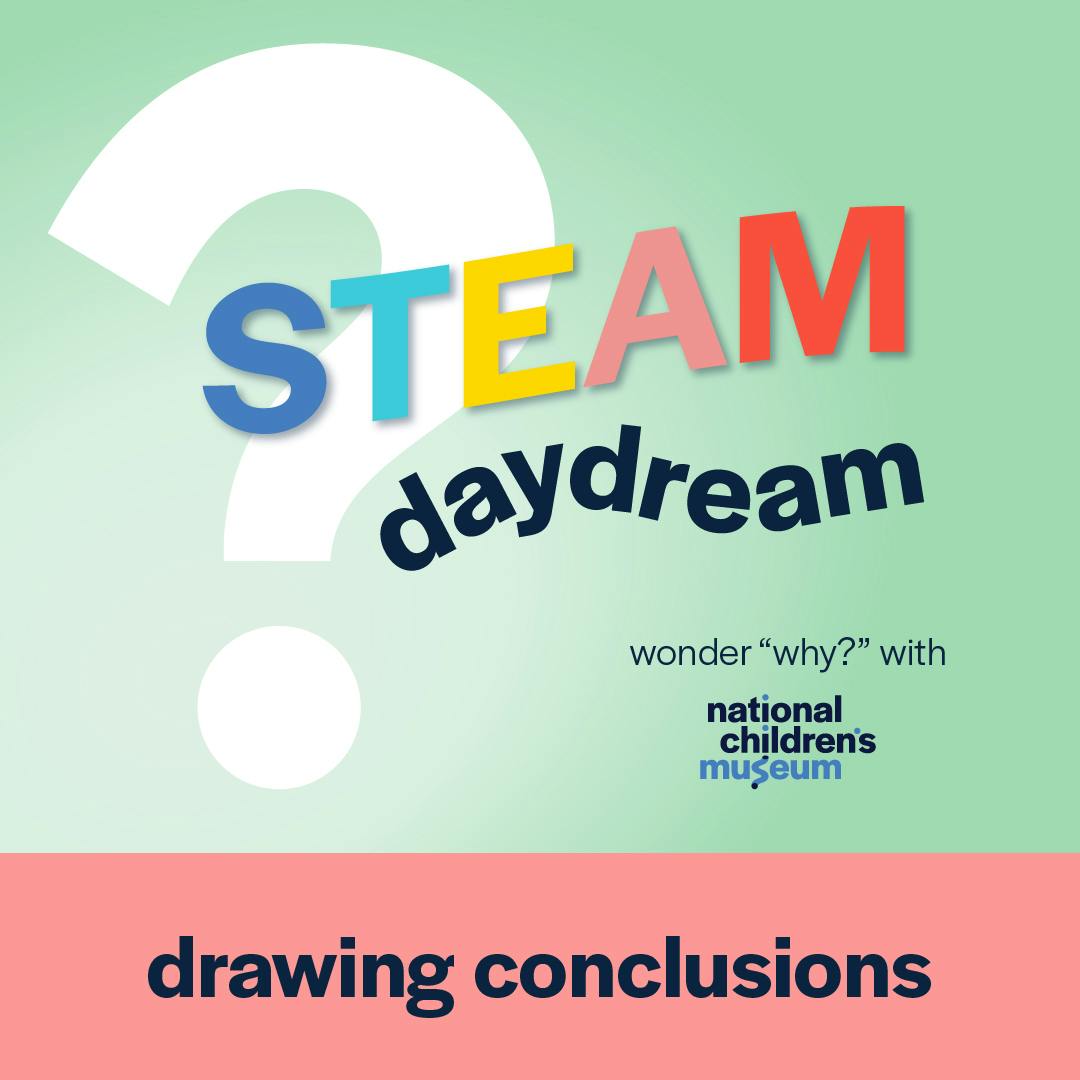drawing conclusions
After using a magical machine called Le Petit Artiste, A.J., Aubrey, and Andre wonder what makes art art. With the help of the Museum’s first-ever artist-in-residence Tommy Bobo and 10-year-old Kid Investigator Olivia S., the STEAM Daydream investigative team compares different masterpieces to draw conclusions about the elements of art.
 meet our kid investigator Olivia S. (she/her) from Heidelberg, Germany 10-years-old favorite school subject: D.E.A.R. (“Drop Everything And Read!”) |
 meet our expert Tommy Bobo (he/him) Artist fun fact: "The only F I ever received on a report card was for an art class in high school. I would grade my current drawing level as C+.” Remember, grades aren't the most important indicator of creativity or success! |
- shapes: two-dimensional areas enclosed by a line or lines
- geometric shapes: shapes based on math principles and made using straight lines, angles, and points (with the exception of circles, which have no straight lines or points)
- organic shapes: shapes, often curvy in appearance, that are similar to those found in nature
- line: a one-dimensional path that connects two points, which can vary in width, direction, and length
- value: describes the lightness or darkness of a color
- space: refers to the use of positive and negative (or white) space in and around a piece of art used to create the appearance of dimension
- texture: how something feels or looks like it would feel
- 5VA:Re8.1.5a: Interpret art by analyzing characteristics of form and structure, contextual information, subject matter, visual elements, and use of media to identify ideas and mood conveyed.
[MUSIC]
AUBREY: Are we almost done? We’ve been cleaning all day!
A.J.: Let’s see... Did we clear out the science experiments from the fridge?
ANDRE: Sure did!
A.J.: Ok… What about Newton’s litter box?
[MEOW/BARK]
AUBREY: Check—but it’s your turn next time, A.J.!
[MEOW/BARK]
A.J.: All right, the last thing on our list is the closet!
ANDRE: Eazy peazy!
AUBREY: Wait, Andre! No—
A.J.: Aubrey?!
AUBREY: I can explain! Last week I was here at the studio all alone, so I turned on the TV, and I was flipping through shows when I found the most magical channel!
TV ANNOUNCER: Get your battery operated boomerang today for just $19.99 and get a second boomerang free! That’s right! 2 battery operated boomerangs for the price of one!
AUBREY: Hm, two for one? Now that’s a good deal!
ANDRE: So you bought a battery operated boomerang?
AUBREY: Yes. Well, actually I bought 10, but for the price of 5! It was such a rush, so I bought a few more things…
A.J.: A few? Aubrey, there’s a mountain of stuff here.
AUBREY: Well I didn’t realize how many things I bought until Maggie the Mailperson delivered it all the next day. I was worried you and Andre would be mad, so I stashed everything in the closet until I could come up with a plan.
A.J.: But then you forgot?
AUBREY: No, I remembered! About 30 seconds ago.
A.J.: Well, if we want to get through all of this junk, we better start sorting.
AUBREY: Hey! It’s not junk. See, look at this!
[MUSIC]
ANDRE: What is it?
AUBREY: This is Le Petit Artiste, or The Little Artist!
VOICE OF LE PETIT ARTISTE: Bonjour, je suis le petit artiste.
AUBREY: Hm, there should be an English setting…
VOICE OF LE PETIT ARTISTE: Hello, I am the little artist.
AUBREY: Oh, there we go!
ANDRE: What does it do?
AUBREY: It makes art! All you do is enter the shapes you want to use, hit go, and wait for it to print out a masterpiece.
ANDRE: Cool! Let’s try it! We’ll say 6 circles, 1 triangle, and 1 rectangle. Ok, go!
[MUSIC]
ANDRE: Wow, a snowperson!
AUBREY: Three circles stacked on top of each other, each one slightly smaller than the one it’s sitting on. Inside the top circle there are two eyes—also circles. A nose—that’s the triangle. And another circle for the mouth. And on top of the circular head there’s a rectangular top hat!
ANDRE: This is so cool! What other treasures are we going to find in this closet?
AUBREY: See, I told you it wasn’t all junk!
A.J.: Hm, this makes me wonder…what makes art, art?
AUBREY: Look, it’s the user manual! I bet the answer is in here… Hmm…
A.J.: It’s in French, isn’t it?
AUBREY: Oui, oui!
ANDRE: I have an idea! Let’s head to National Children’s Museum. We can start our investigation in the Tinkerers Studio, where visitors experiment with creativity and the design process.
[MUSIC]
A.J.: You’re listening to Season 2 of STEAM Daydream with National Children’s Museum, where we solve the world’s many STEAM mysteries one episode at a time: we’ll observe, we’ll ask questions, we’ll investigate, we’ll research, and then we’ll connect the dots—or in this case, the circles and triangles and rectangles—to draw some conclusions about the components of art!
ROBOT VOICE:: Hello, A.J., welcome to the Tinkerers Studio.
ANDRE: You told our Kid Investigator to meet us here at the Tinkerers Studio, right A.J.?
A.J.: Yes, she’s around here somewhere.
OLIVIA: Right here!
A.J.: Oh, good, you made it! Aubrey, Andre, this is Olivia, our 10-year-old Kid Investigator from Heidelberg, Germany! Olivia, welcome to the team.
OLIVIA: Thanks for having me! I’m ready to get this art-y started! Since we’re in the Tinkerers Studio, I thought we could start our investigation with some thoughts from Museum visitors.
[MUSIC]
CHILD 1: My name is Madelyn
FACILITATOR: Madelyn, how old are you?
CHILD 1: Five.
FACILITATOR: Can you tell me what you think art is?
CHILD 1: Well one, I think I can use art to make paper airplanes!
FACILITATOR: Can you tell me what your name is?
CHILD 2: Lizzy, I am five, my favorite colors are purple and blue.
FACILITATOR: What do you think art is?
CHILD 2: You can paint and you can color and it’s really pretty!
CHILD 3: My name’s Nicole and I am seven.
CHILD 4: I’m Abigail, I’m eleven.
FACILITATOR: Can you guys start by telling me what you think art is?
CHILD 3: It’s when you’re coloring something!
CHILD 4: A way someone expresses their imagination!
FACILITATOR: What was the last piece of art that you made?
CHILD 3: The last one I remember doing is a picture, it’s James and the Giant Peach, except it has flying sheep!
CHILD 4: My last piece of art was a lion in the savannah.
FACILITATOR: What do you think makes art, art?
CHILD 4: It’s a whole bunch of things, there’s abstract art, there’s realistic drawing, there’s painting, there’s coloring. Dancing and singing is art because it’s expressing your emotions and like what is happening in your life.
OLIVIA: Hm, interesting. I was thinking of art as drawings, paintings, and sculptures, or what some people call the visual arts. But like some of the Dreamers at National Children’s Museum pointed out, art can come in other forms, too, like dance, theater, and music.
A.J.: Let’s stick to 2D visual art in our investigation today, which is the type of art that’s made on a flat surface like paper or a canvas.
OLIVIA: Ok, we’re going to need to collect some evidence.
ANDRE: We already have this snowperson that Le Petit Artiste made.
OLIVIA: That’s a good start! But I think we need more examples to compare.
A.J.: I have an idea! I’ll set a timer for 2 minutes, and in those two minutes I challenge each of you to create your own snowperson using the art supplies in the Tinkerers Studio. Ready, go!
A.J.: Time’s up! Now before we analyze the evidence, I think I know someone who will be able to help. Tommy Bobo, please report to the Tinkerers Studio. The STEAM Daydream investigative team requests your assistance.
TOMMY: A.J.? I’m right here..
A.J.: Oh, hey! Everyone, meet Tommy Bobo! He was the Museum’s first ever Artist-in-Residence!
OLIVIA: What does that mean?
TOMMY: It means I worked with the Museum to help get people’s creative juices flowing! I love to come up with ideas for families to explore their creativity together.
AUBREY: So you’re an artist?
TOMMY: Yes! I'm an artist. I make all kinds of artwork. Once I turned a house in my neighborhood into a Lighthouse using a bunch of lights and a computer. The last piece I made uses a big fan to blow rainbow streamers and spread rainbows all over the gallery. I also do drawings with pen, pencil, and paper. Often I add watercolors and pastels, and even borrow my kid’s crayons. My drawings help show people what I want to build, and then they help me plan out how I am going to do it.
OLIVIA: Cool!
TOMMY: So, how can I help?
A.J.: We’re trying to figure out the elements of 2D visual art. We collected 4 drawings of snowpeople as examples. The first one was created by this little robot called Le Petit Artiste.
AUBREY: I would say that this one is the most basic of all the snowpeople. Does anything stand out about this one, Tommy?
[MUSIC]
TOMMY: This artwork makes great use of shapes. When a line gets so long and bends that it touches itself, you get a shape. A square or rectangle has four bends before it becomes a shape. A circle is just one long bend. Circles, squares, and triangles are all geometric shapes. Geometric shapes are the shapes that have specific measurements and names. Other shapes are called organic. Those are the shapes we see in nature and when we draw with our eyes closed.
A.J.: It seems like the 4 snowpeople all use very similar shapes, but beyond that they’re all pretty different. Aubrey, tell us about your snowperson.
[MUSIC]
AUBREY: Well, my snowperson is unique because they’re purple! The body is made of 3 stacked circles each colored with a purple crayon! The face is made up of 2 white circles for eyes, a curved, black line for a smile, and I added 2 purple lines coming out of the middle circle to represent arms.
ANDRE: What’s that thing on top?
AUBREY: It’s a rectangular thinking cap, of course!
A.J.: I have to say I’ve never seen a purple snowperson in the wild before, but I like it! What do you think, Tommy?
TOMMY: Well, in addition to shapes, Aubrey decided to use lines and color. Lines are when you draw from one spot to another. They can be super straight or wavy. But watch out if they cross themselves they may turn into a shape. And color is amazing! As artists we use color in all different ways. Color can communicate feelings and mood. We use colors to make other colors look better and brighter, too.
A.J.: Ok, you’re up next, Andre.
[MUSIC]
ANDRE: As I was drawing, I realized something. Snowpeople must get so cold being made out of snow and all. So, I gave my snowperson fur to keep them warm!
OLIVIA: Wow, they really do look furry! How did you do that?
ANDRE: If you look closely, you can see that I added a bunch of tiny little pencil lines all pointing in the same direction around my snowperson’s body, which is made of 3 stacked circles.
A.J.: Wow, cool—I mean, warm!
TOMMY: Andre’s snowperson is a great example of texture. Texture is how you create the surface of an object. You can draw little lines or a pattern to add texture. Or you can crinkle the paper and rub it with something to give it real texture.
A.J.: Ok, last up is Olivia. Let’s see it!
[MUSIC]
OLIVIA: Ta-da!
ANDRE: Hey, we were supposed to make 2D art. Your snowperson looks like it’s 3D!
OLIVIA: It may look like it’s 3D, but I promise it’s not! It’s on a piece of paper just like yours. I added shadows and highlights to my snowperson to make it look like it has depth, like a real snowperson would have. I did it all using a pencil and eraser!
ANDRE: How is that possible?
TOMMY: Well, Olivia darkened some areas and lightened others to mimic how light falls on an object. Every color has different values based on how the light from the room or the sun hits it. Rarely do real life objects appear to be a single flat color. Depending on the light, they will have a different value from their shadowy side to their bright side. Olivia is also using space to make her snowperson 3D. Some of the parts overlap. The nose is in front of the mouth and the top snowball looks like it is hanging over the one below it.
OLIVIA: Ok, so line, shape, color, value, space, and texture are all the things used to make art?
TOMMY: That’s right. They’re called the 7 elements of visual art.
OLIVIA: 7? I only counted six? Which one are we missing?
TOMMY: The last one is form. That’s when a shape is truly three dimensional. Form is less a part of drawing and more important for sculpture. Because the snowpeople we’re looking at today are 2D, they don’t have form, but a snowperson made of actual snow would.
OLIVIA: So we have our answer to today’s question. What makes art, art are the 7 elements!
TOMMY: That’s right! As an artist you can decide which elements you want to use. A creation doesn’t have to use all 7 to be considered art. That’s why art can come in so many forms and part of the reason why these 4 drawings look so different even though they’re all snowpeople.
ANDRE: Ok but… Whose snowperson is the best?
TOMMY: What’s cool is there’s no such thing as the “best”. Art is for and by everyone. What I love about an art piece may not be what you like about it. Art is like ice cream. You don’t have to love every flavor in order to love the idea of ice cream. We each have our favorite flavors, and so next time you’re at a museum or gallery, just like the ice cream shop, you can sample a bunch of different things and find your favorite.
OLIVIA: Oh, let’s draw ice cream next!
ANDRE: Already on it… See?!
AUBREY: Ew! Andre, is that furry ice cream?
ANDRE: Yeah, I’m practicing texture!
AUBREY: Maybe you should try drawing something that’s actually furry—like Newton!
[MEOW/BARK]
[MUSIC]
A.J.: Well, there you have it! Visual art is composed using the elements of art: line, shape, color, value, space, and texture. Plus, form if the art has 3 dimensions. Visit National Children’s Museum and head to the Tinkerers Studio to practice using the different elements in your own artwork. Which element is your favorite to use?
[MUSIC]
A.J.: That’s all for today’s episode, Dreamers! Follow our next investigation turn-by-turn to find out more about GPS navigation! In the meantime, if you enjoyed today’s episode, please leave a review to help other curious kids discover our podcast. Be sure to subscribe wherever you’re listening so you don’t miss our next adventure. You can find more STEAM programs and resources on our website at www.nationalchildrensmuseum.org. Season 2 of STEAM Daydream with National Children’s Museum is generously sponsored by GEICO. It’s narrated by me, A.J. Calbert, produced by Paige Childs, with sound design and engineering by Maddie Zampanti of Conceptual Podcasting. Take Care Dreamers!

